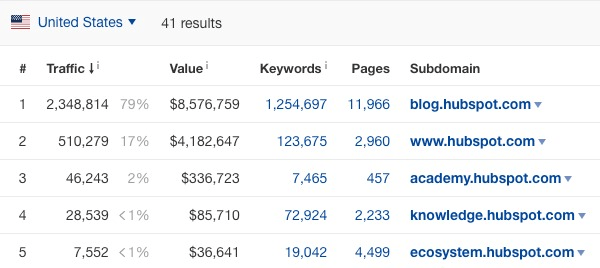In the ever-evolving world of the internet, understanding the structure and function of websites is crucial. Subdomains play a significant role in this landscape, offering both flexibility and organization in website management. This article delves into what subdomains are, their uses, advantages, and how they differ from domains and subdirectories.
What are Subdomains?
A subdomain is a prefix added to a domain name, creating a secondary website under the main domain. It’s a method to organize or navigate to different sections of a website. For example, in blog.example.com, “blog” is a subdomain of the “example.com” domain.
Technical Insight
Technically, subdomains are part of the Domain Name System (DNS), which translates domain names into IP addresses. A subdomain is treated as a separate entity by browsers and can host a distinct website. Each subdomain can have its own DNS records.
Uses of Subdomains
Subdomains have a variety of uses:
Organizing Content: Large websites often use subdomains to categorize content. For instance, a university might use separate subdomains for different departments.
Hosting Blogs or E-commerce Sites: Businesses often use subdomains to host their blog or online store separately from their main website.
Testing and Development: Developers use subdomains to test new features or designs without affecting the live site.
Localization: Subdomains can be used to create region-specific versions of a site, such as us.example.com for the United States audience.
Mobile Websites: Before responsive design became prevalent, a common practice was to host mobile versions of websites on a subdomain, like m.example.com.
Advantages of Using Subdomains
Subdomains offer several benefits:
Improved Organization: They help in organizing the website content neatly and logically.
SEO Benefits: Subdomains can potentially rank in search engine results pages independently of the main domain.
Ease of Use: They are easy to create and manage.
Customization and Flexibility: Subdomains can have different themes, designs, and functionalities from the main site.
Isolation and Security: Subdomains can isolate different website sections, improving security and performance.
Subdomains vs. Domains
While a domain is the main web address of your site (like example.com), a subdomain is an extension of this domain. A domain forms the basis of your online identity, while subdomains act as separate entities under the umbrella of this primary domain.
Subdomains vs. Subdirectories
Subdirectories (or subfolders) are another way to organize content but under the same domain. They appear after the domain (e.g., example.com/blog). Unlike subdomains, subdirectories don’t require additional DNS settings and are seen as part of the main website by search engines.
Creating and Managing Subdomains
Creating a subdomain is typically done through your web hosting control panel. The process involves:
Choosing a Subdomain Name: This should be descriptive of its content or purpose.
Configuring DNS Settings: You might need to point the subdomain to a specific IP address.
Uploading Content: Once created, you can upload content to your subdomain just as you would with a primary domain.
SEO Implications
The use of subdomains can have implications for search engine optimization (SEO). They are often treated as separate entities by search engines, which means they need independent SEO strategies. This can be both an advantage and a challenge, depending on how well the SEO is managed.
Security Considerations
Subdomains can isolate different parts of a website, offering enhanced security. For instance, a compromised subdomain might not affect the main domain. However, proper security measures are essential for each subdomain.
Subdomains are a powerful tool in the arsenal of website management. They offer a way to organize content, manage various website sections efficiently, and can even impact SEO. Whether it’s for hosting a blog, creating a test site, or segmenting an e-commerce platform, understanding and utilizing subdomains can significantly enhance your online presence.
Subdomains extend the functionality and organization of websites, providing a versatile approach to managing online content. As the internet continues to grow and diversify, the role of subdomains in effective web management becomes increasingly important, making them an essential concept for webmasters, developers, and digital marketers alike.
Best Practices for Using Subdomains
Effective use of subdomains can greatly enhance a website’s functionality and user experience. Here are some best practices to consider:
Purpose-Driven Structure: Use subdomains when there’s a clear, distinct purpose that differs from the main site. This could be for hosting a blog, an online store, a forum, or international versions of the site.
Consistent Branding: Even though a subdomain can have a different layout or function, maintaining consistent branding across the main domain and its subdomains is important for user recognition and trust.
SEO Strategy: Since subdomains can be treated as separate entities by search engines, it’s crucial to have a distinct SEO strategy for each subdomain. This includes keyword research, content creation, and link-building specific to the subdomain’s theme or purpose.
Navigation and Accessibility: Ensure that users can easily navigate between the main domain and subdomains. Clear and intuitive navigation enhances user experience and helps in retaining visitors.
Monitoring Performance: Regularly monitor the performance of your subdomains with web analytics tools. This will help in understanding user behavior and making necessary adjustments.
Challenges with Subdomains
While subdomains are beneficial, they come with their own set of challenges:
Resource Allocation: Each subdomain can require separate hosting resources, management, and maintenance, which can be resource-intensive.
SEO Complexity: Managing SEO for multiple subdomains can be more complex than handling a single domain. There’s a risk of diluting your main site’s SEO efforts if not managed properly.
Cross-Domain Tracking: Tracking user behavior across subdomains and the main domain can be challenging. It requires proper configuration in analytics tools to accurately track and interpret user data.
Security Management: Each subdomain needs its own security measures, which can increase the overall management complexity.
Case Studies: Successful Use of Subdomains
Many large organizations and businesses successfully use subdomains. For instance:
E-commerce Stores: Amazon uses different subdomains for various country-specific stores, like uk.amazon.com for the United Kingdom, effectively managing localization.
Blogs and Media Outlets: Major news websites often host their blogs on subdomains, allowing for distinct content management and style, separate from the main news website.
Educational Institutions: Universities frequently use subdomains for different departments, making it easier for users to find relevant information.
Future of Subdomains
The future of subdomains remains bright as they continue to offer a level of flexibility and organization that is hard to match with other structures. With the advancement in web technologies and content management systems, the creation and management of subdomains have become more accessible and efficient.
In the era of AI and machine learning, the way search engines view and rank subdomains might evolve, further integrating them into overall SEO and digital marketing strategies.
Subdomains are a vital component in the architecture of the web. They offer a unique combination of flexibility, organization, and functionality. Understanding their role, benefits, and best practices is crucial for anyone involved in web development, digital marketing, or online content management. As the digital landscape continues to evolve, so will the ways we use and perceive subdomains, making them an enduring and dynamic element of the online world.
Top 10 well known companies that use public subdomains
Subdomains are widely used by many well-known companies for various purposes like organizing their content, offering localized versions of their services, hosting blogs, or creating distinct platforms for different facets of their business. Here’s a list of ten well-known companies and how they use subdomains:
Google (maps.google.com): Google uses subdomains extensively, with ‘maps.google.com’ being one of the most prominent. This subdomain is dedicated to Google Maps, providing geographical information and directions.
Amazon (smile.amazon.com): Amazon uses the ‘smile.amazon.com’ subdomain for its Amazon Smile program, where a portion of the purchase price is donated to a charity of the buyer’s choice.
Facebook (developers.facebook.com): Facebook uses this subdomain for its Developer platform, where developers can find resources, tools, and guides to build apps and services that integrate with Facebook.
Yahoo (news.yahoo.com): Yahoo News is hosted on a subdomain, separating news content from Yahoo’s other services like email and finance.
Microsoft (developer.microsoft.com): This subdomain is used for Microsoft’s developer resources, offering documentation, tools, and support for developers working with Microsoft technologies.
eBay (motors.ebay.com): eBay Motors, dedicated to automotive sales and auctions, operates under its own subdomain, distinguishing it from eBay’s general marketplace.
Adobe (helpx.adobe.com): Adobe uses this subdomain for its Help and Support portal, providing user guides, tutorials, and community forums.
LinkedIn (learning.linkedin.com): LinkedIn Learning, which offers professional courses and skill development resources, is hosted on a separate subdomain.
BBC (news.bbc.co.uk): The BBC uses a subdomain for its news section, offering an extensive range of news services separate from its entertainment and educational content.
Salesforce (developer.salesforce.com): Salesforce has a dedicated subdomain for developers, providing resources, documentation, and community support for building on the Salesforce platform.
These examples illustrate the diverse use cases for subdomains across various industries. Companies leverage them to organize their offerings, provide specialized services, and enhance user experience by clearly segmenting different aspects of their online presence.











